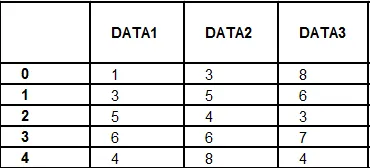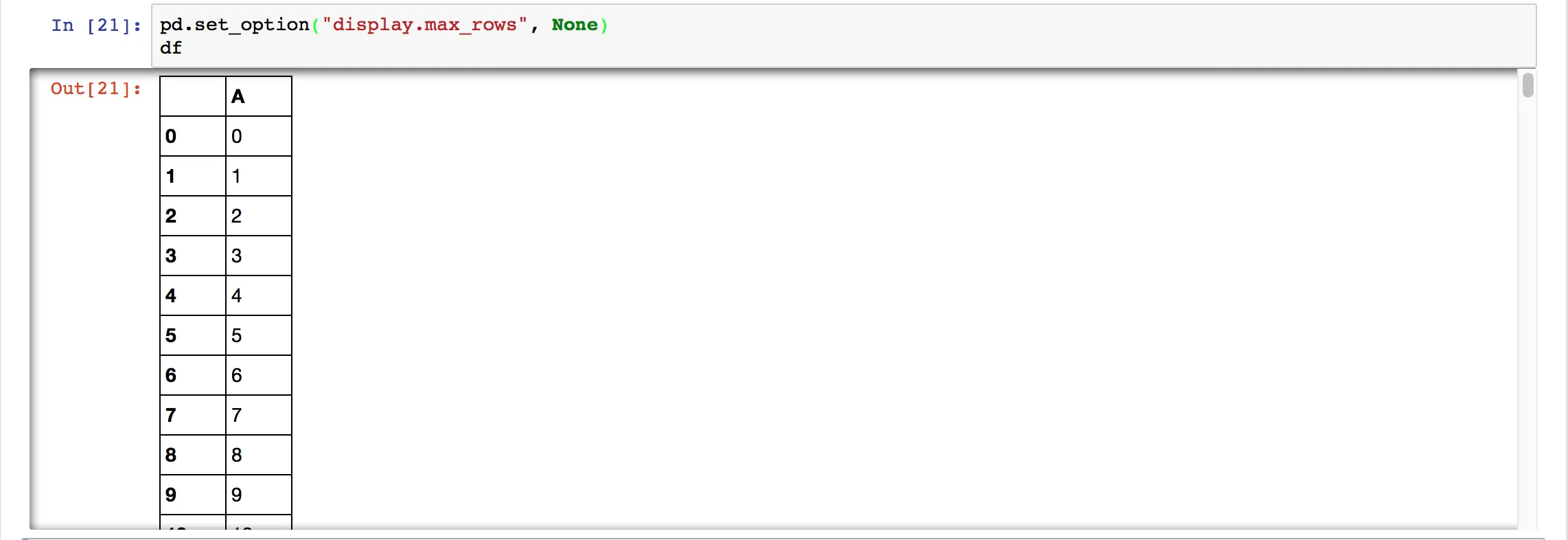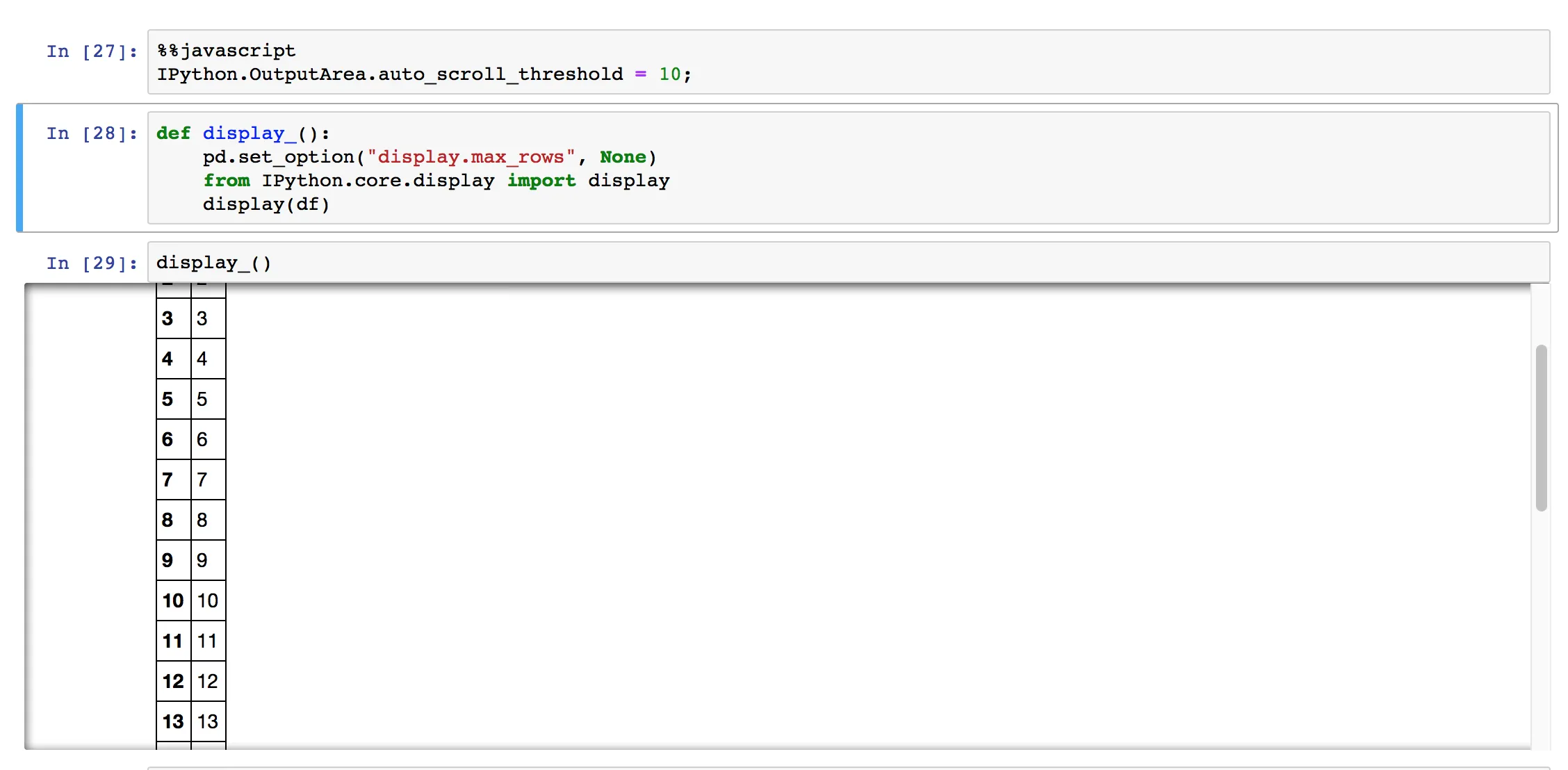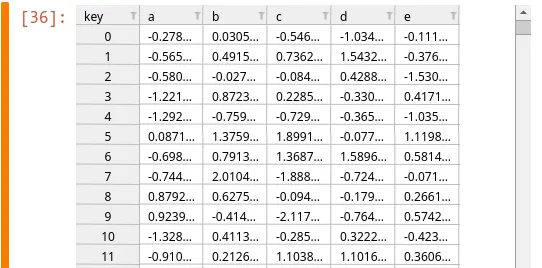4个回答
21
我不确定这是否是您的意思,但我猜您需要将max_rows选项设置为None,以便pandas不会限制显示的行数:
pd.set_option("display.max_rows", None)
更新:
In [27]:
##javascript
IPython.OutputArea.auto_scroll_threshold = 10;
In[28]:
def display_():
pd.set_option("display.max_rows", None)
from IPython.core.display import display
display(df) #df must be defined up there
- Psidom
8
16
另一个答案对我没用——IPython.OutputArea似乎不再存在(就我所知,至少在VSCode和基于IPython的代码中不再存在)。
我用一种比较巧妙的方法使一个数据框可以滚动:生成数据框的HTML表格,然后将其放入一个 div 中,可以使用CSS使其可滚动。在这种情况下,我们只需要将高度设置为某个像素值即可。
我们还可以将溢出设置为auto,宽度设置为fit-content,以便滚动条出现在数据框旁边,而不是窗口右侧。
import pandas as pd
from IPython.display import display, HTML
df = pd.DataFrame([(i, i) for i in range (20)])
pd.set_option("display.max_rows", None)
# Puts the scrollbar next to the DataFrame
display(HTML("<div style='height: 200px; overflow: auto; width: fit-content'>" +
df.style.render() +
"</div>"))
# Puts the scrollbar on the right side of the window
display(HTML("<div style='height: 200px'>" + df.style.render() + "</div>"))
演示:
- Bernhard Barker
2
这个方案非常好,我喜欢它!唯一的改变是将
height 替换为 max-height,以防止表格在其中有少量项目时占用不必要的空间:display(HTML("<div style='max-height: 400px'>" + pd.DataFrame(records, columns=columns).to_html() + "</div>")) - zaaath这很不错。有没有办法用这个解决方案覆盖用于渲染pd.DataFrame的标准显示函数? - Bananeen
7
只需传入数据框,观察魔力。
def table(df):
import plotly.graph_objs as go
fig = go.Figure(data=[go.Table(
header=dict(values=list(df.columns),
align='left'),
cells=dict(values=[df[i] for i in df.columns],
align='left'))
])
return fig
- ASAD ASHRAF KAREL
4
2能否解释一下为什么在这种情况下使用plotly是一个好的库,也许可以展示一下它看起来是什么样子? - totokaka
1事实上,我在使用plotly时感觉非常舒适。它提供的信息比matplotlib和seaborn更加详细。当然,用户还可以根据需要选择其他库。 - ASAD ASHRAF KAREL
对我来说,这只是返回一个空单元格。在Jupyter Notebook 7.0.3上使用plotly-5.16.1。 - undefined
只适用于Jupyter Lab 4.0.5(因此不适用于Jupyter Notebook,仅适用于Jupyter Lab)。 - undefined
0
使用ipydatagrid:
import string
import numpy as np
import pandas as pd
N = 5000
cols = {char:np.random.randn(N) for char in string.ascii_lowercase[:5]}
df = pd.DataFrame(cols)
from ipydatagrid import DataGrid
DataGrid(df)
- robertspierre
网页内容由stack overflow 提供, 点击上面的可以查看英文原文,
原文链接
原文链接
- 相关问题
- 4 如何将pandas DataFrame插入现有的PostgreSQL表格?
- 5 Pandas DataFrame styler - 如何将 Pandas 数据框样式设置成 Excel 表格?
- 4 使用Bootstrap表格将Pandas DataFrame转换
- 3 Pandas DataFrame样式丢失表格边框。
- 9 Pandas:DataFrame内嵌DataFrame
- 14 将 Pandas DataFrame 转换为 Orange 表格
- 6 将Pytables表格转换成pandas DataFrame
- 70 从pandas DataFrame导出一个LaTeX表格
- 8 Pandas DataFrame转Excel:索引垂直对齐
- 10 将Latex表格读入Pandas DataFrame





def display_(): pd.set_option("display.max_rows", None) from IPython.core.display import display display(df)- Psidom